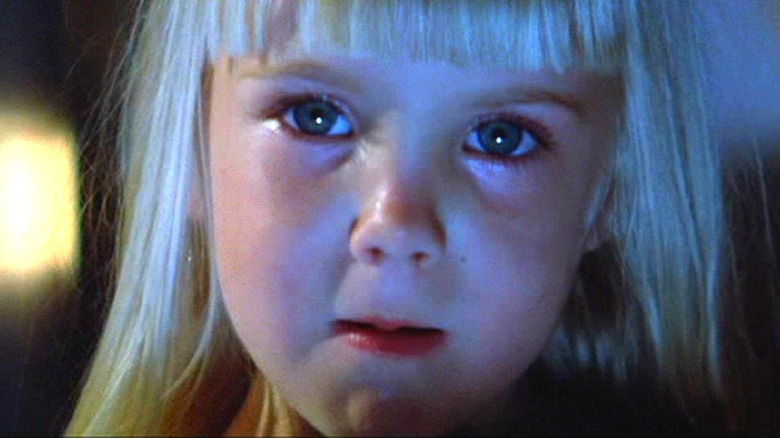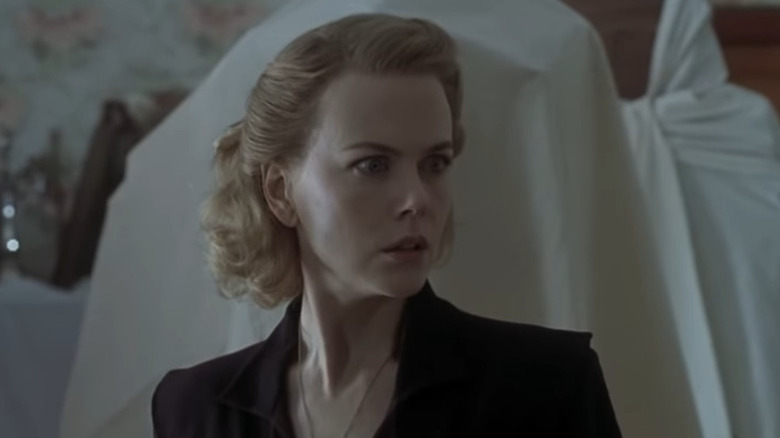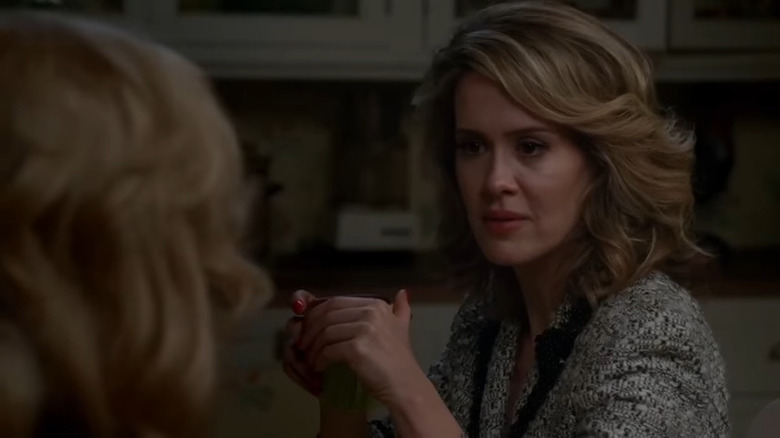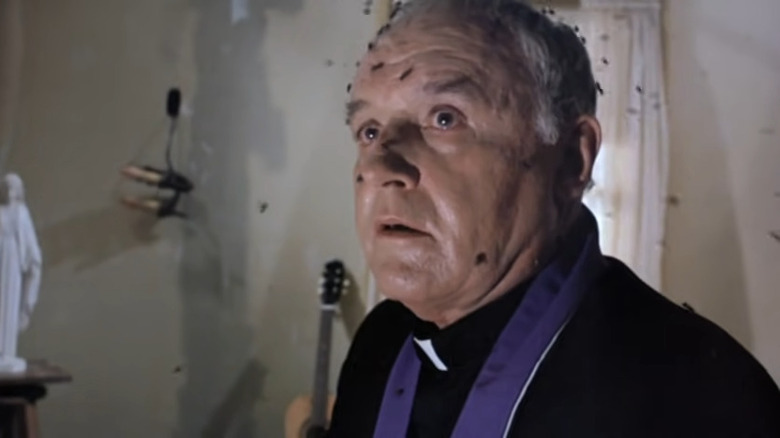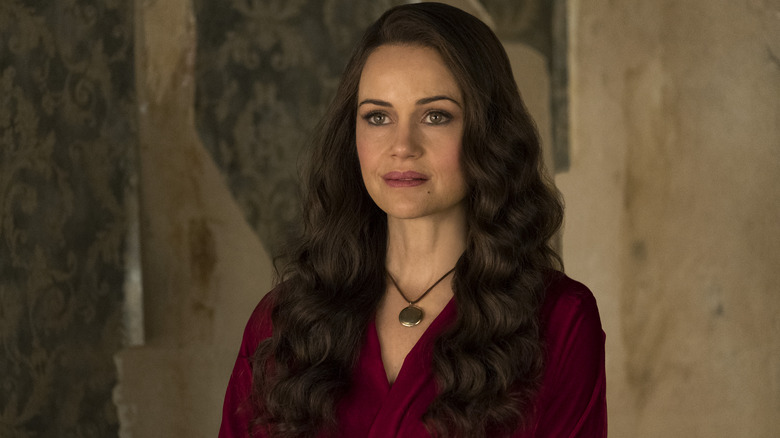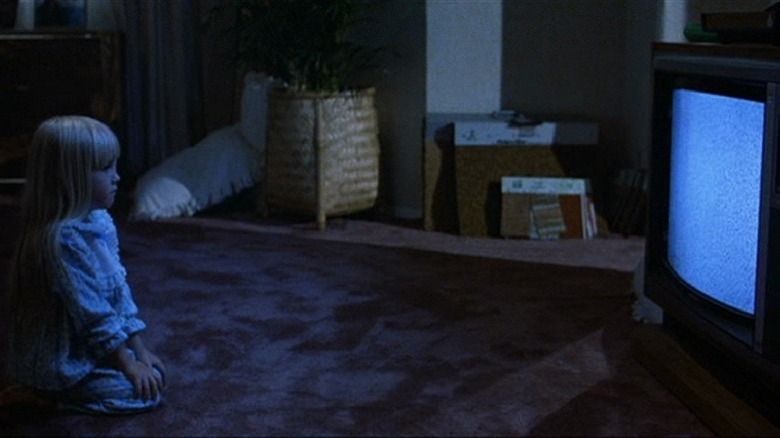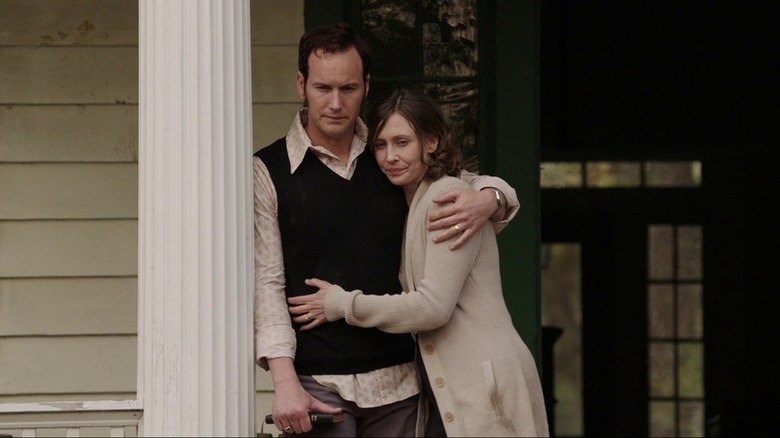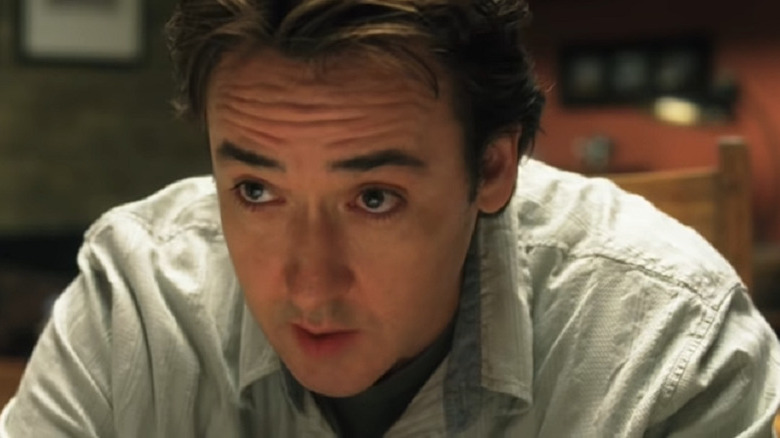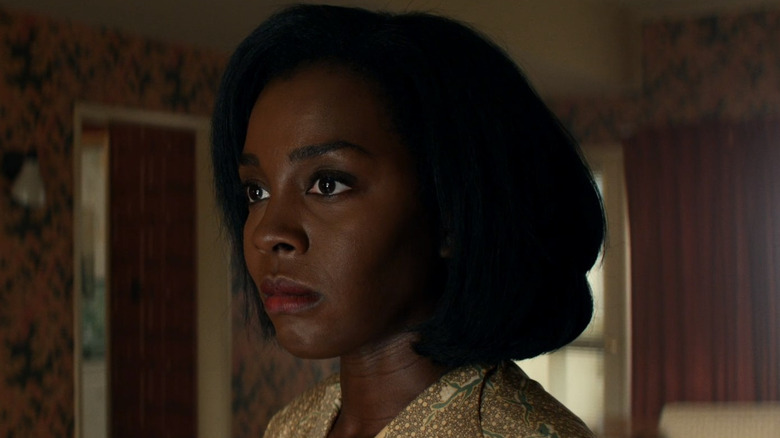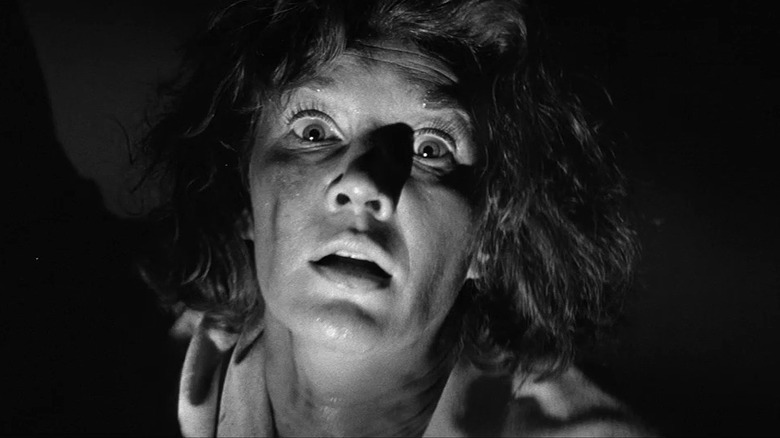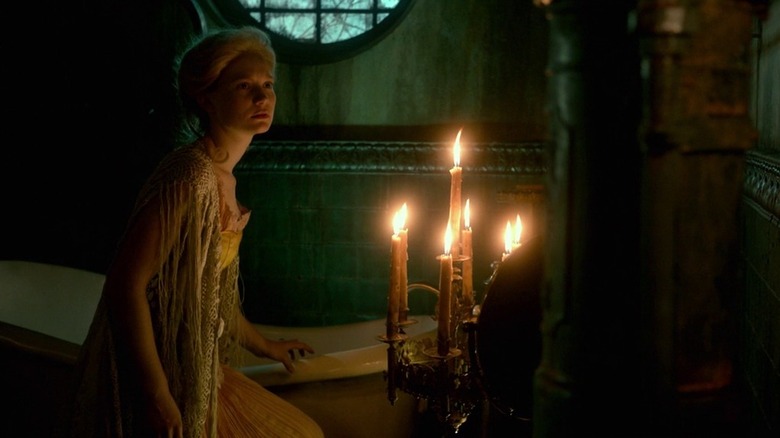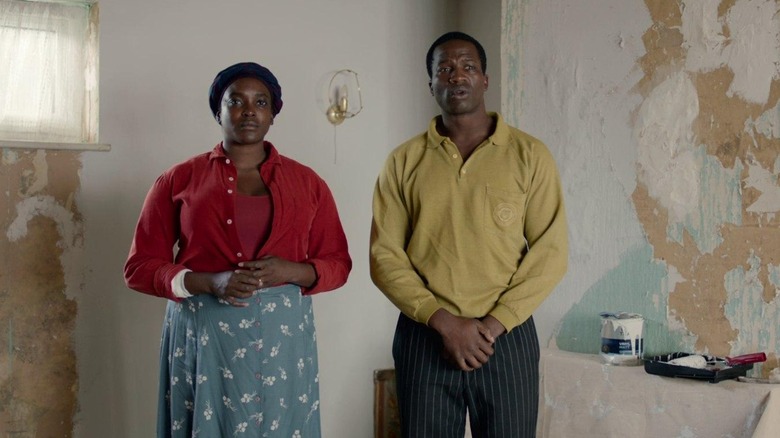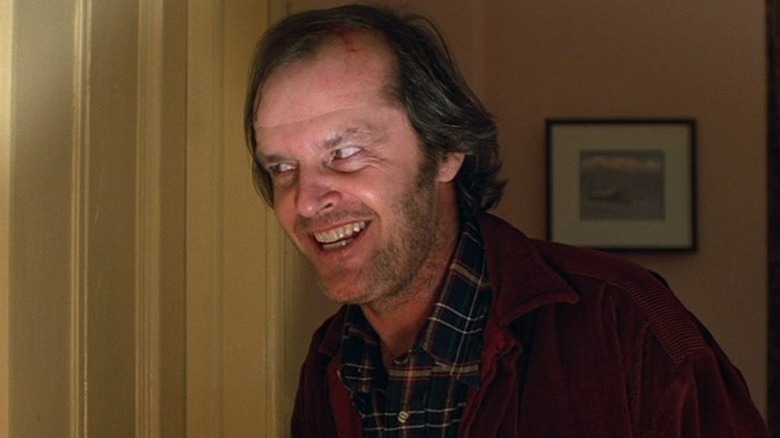12 Haunted House Movies And TV Shows That'll Scare Your Socks Off
Jean-Paul Sartre once said, "Hell is other people." Yet as countless haunted house movies have demonstrated, hell is also a place where the dead terrorize the living in the comfort of their own homes. In a sense, there is no greater horror than the haunted house. Our homes are the one place where we expect to find a refuge and sanctuary from the chaos of the world and the evil intent of others. Yet when the place where we should feel safe and secure becomes the stuff of horror films, the results are often terrifying.
No matter the age or size of a house, we've all at some point, laid awake in the early hours and been plagued by unsettling noises, a peculiar sense of unease, and the endless scope of our imaginations. When you're half-asleep, moonlight and shadows can take the contours of the familiar and commonplace and transform them into something threatening and horrific. Likewise, nooks, crannies, and corners you pay no mind to in the waking hours become secret places where demons and ghosts await an opportunity to pounce.
Thankfully for most of us, such fanciful notions evaporate in the first rays of the morning sun. Yet what if they didn't? Here are 12 of the best haunted house movies and TV shows that'll make you think twice before turning off the lights.
1. The Others
It's a common horror trope that ghosts only haunt a property or geographical location because they're restless souls who have unfinished business in the land of the living. Possibly because they were ripped from their earthly existence too soon, or have some sort of message that needs delivering. Or just maybe, they refuse to move on to pastures new because they don't even know they're dead. That's the premise of "The Others," skillfully brought to life by director Alejandro Amenábar. In a haunted house movie that's low on gore but big on suspense, Nicole Kidman puts in a classy performance as Grace Stewart, who rattles around an isolated country house with only her children and a few serving staff to keep her company.
Set in the immediate aftermath of World War II — which claimed the life of her husband — Grace is haunted by the unnerving notion that something in her house isn't quite right. Pianos which play themselves, footsteps along deserted corridors, and ghostly sightings of what come to be known as "The Others," all conspire to convince Grace her humble abode is haunted. While Grace's fears are confirmed, it is not in the way she imagines, and "The Others" twist ending has an undeniably powerful impact when first viewed. "The Others" is a slow burner but this doesn't diminish its effectiveness, and it haunts the viewer with its melancholy atmosphere.
2. American Horror Story: Murder House
When the American Horror Story franchise premiered with "Murder House" way back in 2011, Ryan Murphy and Brad Falchuk reminded audiences of the endless ways a haunted house can scare us senseless. The "Murder House" isn't just haunted, it's home to a motley collection of ghosts, all with an intriguing story to tell and a part to play. "Murder House" is a great example of how a TV show can be both entertaining and scary. The tempo is brisk, the performances compelling, the twists are genuinely shocking, and the black humor stops the horror from getting too dense and claustrophobic.
The haunted house formula is simple, and "Murder House" doesn't reinvent the wheel, but it does introduce some fun elements to the party. It is both a homage to the great haunted horror stories of yesteryear, while being very much its own beast — strange, sinister, over-the-top, sometimes camp, but always completely engaging.
Inside the walls of the "Murder House," the dead and the living converse — in defiance of the standard laws of how a haunted house should operate. Once the troubled Harmon family moves in, it's open season as a long line of murderers — and the murdered who have lived in the house for nearly a century — take their place in the spotlight and haunt the hell out of the Harmons. Alongside "Asylum," "Murder House" is easily the spookiest American Horror Story season. Suspend your disbelief as to why anyone in their right mind would want to live in a house like this and enjoy the ride — it's exhilarating.
3. The Amityville Horror
Since Jay Anson published his bestselling book, "The Amityville Horror" in 1977, there has been a glut of film and TV shows based on the Lutz family and the gruesome events at 112 Ocean Avenue. While they vary in quality, it was the first film in 1979 that set the bar for the ones that would follow.
One of the biggest selling points of Stuart Rosenberg's version of "The Amityville Horror" was that it was purportedly based on real events — an idea that terrified audiences back in 1979. Nowadays watching a movie involving demonic possession is routine, but 30-something years ago — with the exception of "The Exorcist" — it wasn't, particularly if you were compounding the cinemagoers' dread with the disclaimer that it was all factual.
Of course, the only hard and fast truth regarding "The Amityville Horror" was that before the Lutz family moved in, Ronald Joseph DeFeo Jr. was responsible for killing both his parents, his two brothers, and two sisters at the house in 1974 (via The New York Times). The Lutz family was aware of this before moving in but thought they could handle it, however, ABC News reports that the family left 28 days later. Any haunting that was said to have happened at the address is widely disputed, however, George Lutz insists it is true — and even believed the house could have driven DeFeo to kill. This idea remains the scariest aspect of "The Amityville Horror," and watching it unfold is an undeniably tense and harrowing experience.
4. The Haunting of Hill House and The Haunting of Bly Manor
You can often identify a haunted house just by looking at the exterior before the scares have even begun. They tend to have a still, solitary, and watchful aura with a heavy presence that casts a shadow over everyone who rocks up to their imposing and unwelcoming door. Governed solely by their instincts — and not reason or logic — animals often won't cross the threshold of a haunted house. However, as Mike Flanagan's "The Haunting of Hill House" and "The Haunting of Bly Manor" remind us, humans have a long history of trying to make the inhabitable habitable — often with a significant cost.
Based loosely on Shirley Jackson's classic novel of the same name, the horrors in "The Haunting of Hill House" are subtle, suggestive, unrelenting, and fierce. Unlike many other haunted house movies, the haunting doesn't stop when the inhabitants leave but instead follows them throughout their lives.
True horror only works if it plays on the fears that lie deep in the heart and both shows do precisely that. "The Haunting of Hill House" suggests that traumatic childhood experiences are capable of haunting us more hellishly than any house. "The Haunting of Bly Manor" similarly relies on the fear of the unknown, the otherworldly perception of children, and the thin line between life and death for its impact. While not as scary as "The Haunting of Hill House," it has just as much heart and deftly reveals that behind every haunted house there is usually a human face and heart.
5. Poltergeist
When you move into a newly-built house it's usually safe to assume that you shouldn't be too concerned about being haunted by ghosts. Yet as Tobe Hooper's "Poltergeist" pointed out, just because the bricks are new and the roof freshly laid, it doesn't mean that the earth the house is built upon is not cursed or haunted. Released in 1982 and based on an original story by Steven Spielberg, "Poltergeist" would become a horror classic.
The ghosts in "Poltergeist" don't just believe in operating from the standard haunted house textbook — they think bigger than unsettling noises, moving furniture, and unpleasant odors. In this film the spirits don't just haunt, they abduct a little girl called Carol Anne (Heather O'Rourke) by dragging her through the TV and taking her to the other side.
It's truly the stuff nightmares are made of. Ghosts shouldn't be able to haunt new buildings or talk through the TV, but in "Poltergeist" they do. The only hope the Freeling family has of saving their daughter from the clutches of what we learn is called the "Beast" is to call in an eccentric spiritual medium named Tangina Barrons (Zelda Rubinstein). By locating the portal to another dimension in a kids' closet and making the TV the focal point of haunted activity, "Poltergeist" dragged haunted houses out of the Victorian ghost story and made them very real and plausible for a new generation. The film also offered sound advice to potential property developers — never build on old burial sites.
6. The Conjuring
James Wan's "The Conjuring" is one of those films that'll haunt your imagination long after the final scene. As haunted house films go, it plays with the full deck, including demonic forces, a possessed mom, ghost hunters, a brutal exorcism, and of course, a new home with a terrible history. The 2013 film that launched a franchise oozes sinister intent from the first frame and is also reportedly based on a true story (via IGN).
The film focuses on husband and wife Ed and Lorraine Warren (played by Patrick Wilson and Vera Farmiga), who were America's most famous paranormal researchers. As well as documenting the plight of the Perron family featured in "The Conjuring" they also investigated the notorious Amityville House haunting.
Although the film takes certain liberties regarding the truth of what actually occurred in the Perron's haunted farmhouse, the real Lorraine Warren — who acted as a consultant for the movie — told USA Today, "The things that went on there were just so incredibly frightening." In the same article, the Perron's eldest daughter Andrea described the movie as "a beautiful tapestry" containing "many elements of truth to it, and some moments of fiction." Regardless of how loyal it remains to real-life events, "The Conjuring" is one of the scariest films you'll ever watch because it makes everything that happens in the film feel so believable. There is nothing fantastical about the haunting in this film — it is wretched, harrowing, primal, and speaks directly to the place in all of us where irrational fears reside.
7. 1408
For every haunted house there's a cynical skeptic who will dismiss any night terrors as the product of an over-active and over-wrought imagination. In "1408," Mike Enslin — played with contemptuous snark by John Cusack — is that sneering unbeliever. Based on a Stephen King short story and directed by Mikael Håfström, the film involves Enslin traveling around America, staying in haunted hotel rooms, and writing books about his distinct lack of paranormal experiences. That is until he spends the night in the notorious room "1408" at New York's Dolphin Hotel. Despite the hotel manager (Samuel L. Jackson) pleading with Enslin not to stay in a room that 56 people had died in, Enslin is adamant he can debunk the superstitions around it.
Within the space of an hour, it dawns on Enslin that the room is not just haunted but psychopathic — hell-bent on forcing him to check out of both the hotel and the mortal realm. Like room 237 in "The Shining," room 1408's power is one of suggestion and its scalpel-like ability to peel back the layers of its occupant's mind and twist the knife. Inside the room, he is haunted by both his past and that of others as The Carpenters' "We've Only Just Begun" plays repeatedly on his bedside radio. Events unfold in this tense and clever psychological film with all the unpredictability and chaos of a bad trip. Enslin believes at times that it cannot be real, but what can be more real to an individual than the perception of their own mind?
8. Them
A TV series about a Black family relocating from rural North Carolina to an all-white Compton suburb in 1953 had the potential to be unsettling enough. But when you add a host of malevolent and demonic forces to the mix, the horror becomes multi-faceted. Created by Little Marvin and expertly acted by a great cast, the first season of "Them" contrasts the everyday racism in '50s America with the terror of haunting supernatural entities.
Hoping to escape a harrowing past, the Emory family moves to a new home in Los Angeles looking for a new start. However, the prejudice and otherworldly forces that live there have other ideas. Haunted by something vile in the basement of their new home and terrorized by their neighbors, the Emory family is attacked day and night by those that seek to destroy them.
"Them" is unrelenting and a hard watch at times. The huge mental and physical cost it takes to live in a hostile world that constantly views you as the "other" is portrayed in a series of exhausting and abrasive events. Both the racism and supernatural horror in "Them" has a creeping and hidden quality at first. It is hidden in plain sight but slowly reveals its true face, which is every inch as vile and hideous as you'd imagine. "Them" is a story of a family striving to fit into a world that won't accept them and a house that hates them. It's designed to get under the viewer's skin for a reason and it achieves it with both style and substance.
9. The Haunting
Long before "The Haunting of Hill House" there was 1963's "The Haunting." Directed by Robert Wise and also based on Shirley Jackson's 1959 classic novel, the black and white film has an unsettling edge and an atmospheric unease that is hard to beat and almost impossible to replicate.
As a place where numerous gruesome things have occurred, Hill House has earned a reputation and the film centers around a group of paranormal investigators who visit the house to find out if there's any truth in it. As you can imagine, it doesn't take long before things start going bump in the night, convincing the visitors to abandon any skepticism and focus on trying to survive the horror.
As is only fitting, the true star of "The Haunting" is the 90-year-old Hill House itself. Constructed at odd angles with all manner of secret rooms, and an imposing spiral staircase, Hill House appears as if it was destined to be haunted. The most disturbing aspect of "The Haunting" is watching how events slowly get under the skin of the occupants and cause their mental unraveling, as their rational minds try and cope with the unexplainable. There is nothing visually shocking or disturbing in "The Haunting" by today's standards, but the film perfectly captures the psychological effects a supernatural experience — whether real or imagined — can have on an individual's mind.
10. Crimson Peak
From its opening line, "Ghosts are real. This much I know," Guillermo del Toro's "Crimson Peak" has a gothic air of mystery and a pitch-perfect haunted house to match. From its crumbling roof, its winding staircase, the shadowy corners filled with autumnal leaves, and its sprawling hallways that seemingly stretch on into the afterlife, Allerdale Hall sits at the center of this beautifully-filmed horror.
The house positively broods with a terrible history of sinister secrets and tormented souls and sits upon a disused mine of blood-red clay. You don't have to be Sherlock Holmes to deduce there's a high chance that it's teeming with restless spirits. Allerdale Hall is the family manor of the melancholy Sir Thomas Sharpe (Tom Hiddleston) and his aloof sister Lucille (Jessica Chastain). When Sharpe's new wife, Edith Cushing (Mia Wasikowska) moves from America to the house in Edwardian-era England, things take a turn for the worse.
No sooner has Edith got a foot in the door than she is plagued by ghostly visitations — all rendered with Guillermo del Toro's trademark skill. If you like your haunted house movies atmospheric then it doesn't get much better than "Crimson Peak." The tempo never misses a beat and the performances are top-notch — particularly that of Tom Hiddleston who carries a haunted air of his own throughout. There are jump scares, unsettling moments, and a telling reminder that although ghosts may haunt us, it is flesh and blood that can hurt us.
11. His House
As a rule of thumb, the older and bigger a house is, the more we tend to believe it'll be haunted. A house that has been home to successive generations has history and secrets, and chances are a few ghosts from times past to haunt the present. In contrast, director Remi Weekes' "His House" completely abandons the notion that only old houses can be scary. The story of a husband and wife who flee war-torn South Sudan to a small council house in England is eloquently told and breathes new life into the haunted house genre. Refugees Bol and Rial (Sope Dirisu and Wunmi Mosaku) make a harrowing trip across the English Channel for a new life and a new beginning, but it turns out the real horror has yet to show its face.
The domestic mundanity and bleak modernism of their new home provide a jarring contrast with the supernatural and demonic terror that haunts their new abode. Determined not to return to a country ravaged by brutality and violence, Bol and Rial rise above the racism, and cynical suspicion of the country they now call home. However, the demonic forces that have followed them to their new house pose the biggest threat. "His House" is genuinely spooky and its terrors have that surreal and dreamlike quality capable of unnerving the most hardened horror fan. Its message that it's not just houses but people who are haunted by their past — and Bol's grim realization that "Your ghosts follow you" — makes "His House" a more than welcome addition to the genre.
12. The Shining
The forces that haunt the Torrence family and the viewer in Stanley Kubrick's "The Shining" were far too big to be contained by a mere house, so a whole hotel was needed. And as anyone familiar with this classic horror movie will know, the Overlook Hotel is the motherlode of haunted premises. From its isolated location, its strange and macabre history, and its brooding and menacing presence, the hotel ticks all the boxes. The Overlook doesn't so much haunt Jack Torrance (Jack Nicholson) but rather makes him its pet project from the get-go. The forces that haunt the Overlook with all the strength of a sledgehammer are the very same forces that lie on the edge of reason and in the dark places between the stars.
Iconic scenes from "The Shining" have seeped into popular culture: The naked old lady in the bath, the Grady daughters, and Lloyd the bartender have haunted viewers for four decades. As for the Overlook Hotel, it has a familiarity and a strangeness that all buildings — devoid of fellow human beings — can possess in the twilight hours. It turns time and reason on their head and if any of the occupants have an already troubled soul or a damaged mind, it takes hold with terrifying consequences. "The Shining" continues to haunt audiences with the message that our minds can play terrible tricks upon us, and all that is familiar and safe can change in a heartbeat if we find ourselves lost and stranded in a place that defies explanation.
